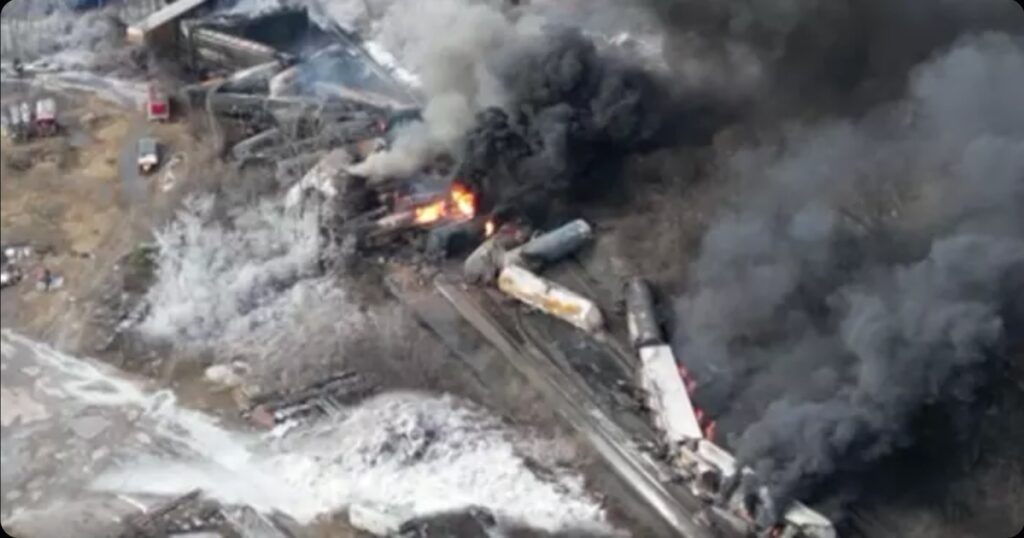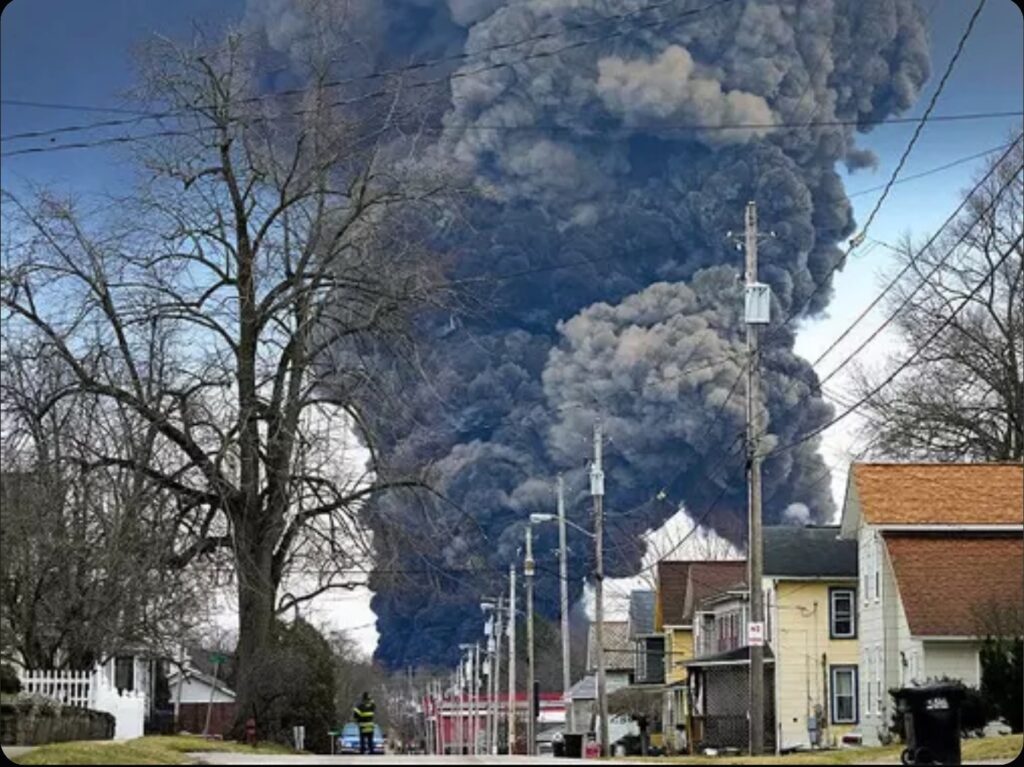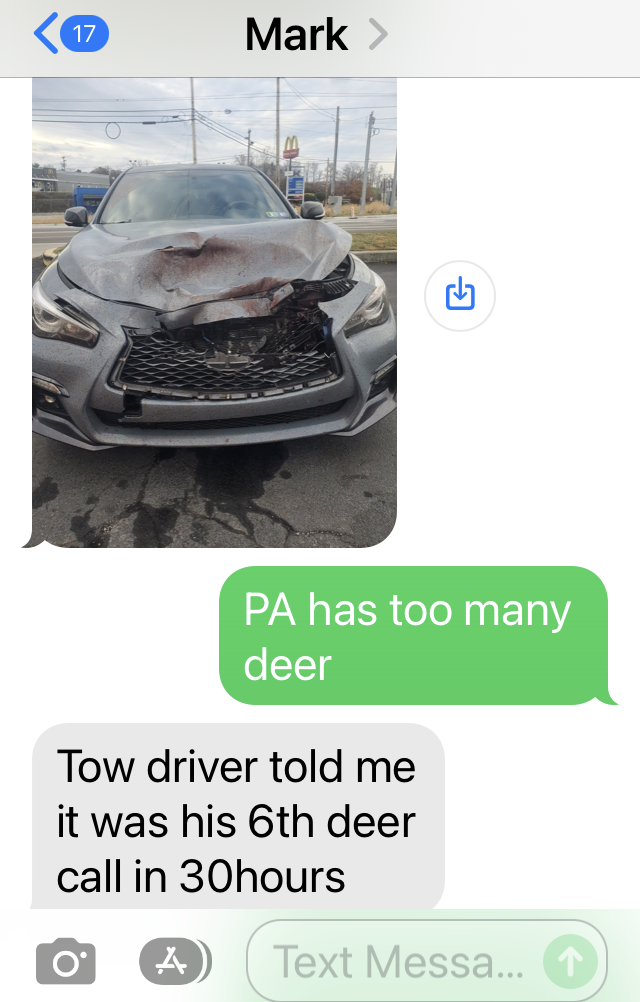Posts Tagged → crash
99 Red Flags

Catastrophic Norfolk Southern train wreck in East Palestine, Ohio. “President” Biden still has not visited, but he has flown to Ukraine

Waterways and drinking water in East Palestine, Ohio, are badly contaminated. But the federal government says no aid is available to help

Train wreck mushroom cloud hangs over East Palestine, Ohio, whose toxic mess was greatly exacerbated by the way the federal government employees tried to mitigate the toxic chemicals in it
A red flag is used in car racing, team sports, and other activities to indicate a warning about something dangerous, or as a disqualification of some player or person, usually for breaking the rules of the game.
A new genre of “red flag” laws are being used to illegally disarm law abiding Americans, but that is a whole other subject. Even in this case, the term “red flag” serves the same connotation as elsewhere.
Recently America has experienced a whole slew of red flags as both warnings and as DQs. I don’t know how many red flags there have been, but there are easily a hundred of them. Let’s just say for argument’s sake that there are 99 red flags that we all should have seen in the past two years.
Examples of the warning kind include a handful of planes haphazardly and inexplicably flying into food processing plants out in the middle of nowhere, dozens of catastrophic mysterious fires breaking out at food processing plants and chicken farms, mysterious diseases striking large numbers of beef cattle and chickens at ranches and egg laying plants, adulterated chicken feed suppressing egg laying chickens from laying eggs across America for the past six months, and sophisticated attacks on electricity plants and on public water plants.
Now, when any one of these things happens, it is news. Or at least it should be news, and maybe it is news that such a freak event did not make the regular news. But when all of these things happen all of a sudden, across a relatively compact and short amount of time, with huge shockwaves sent through the American food supply chain that end up with empty super market shelves and very high food prices, it is all beyond news. This is happening on purpose. Each of these events is then a huge red flag that something is wrong. Something bad is happening to the infrastructure of our daily American lives, and if we do not understand what is happening, then we will not be able to address it. And if we do not address it, then we Americans will have little or no food to eat or clean water to drink.
When I talk to friends and strangers alike (I talk to strangers all the time) about these apparent overt attacks on our American food supply, I get a couple responses. One is “Wow, I had no idea. I guess that is why I see empty store shelves and high prices. Hmmmmm.” This response indicates the person is starting to think ahead about what this means for them, and what can they do about it. Self preservation in action.
The other response I get is “Really? I had no idea. Oh well.” And this indicates the person is so deeply asleep in the fat of the land that they cannot imagine either going without food, or how they can go about fixing their situation. Some joke about who will starve during a famine or domestic conflict, and it is no joke – these inattentive and incurious people will end up being the designated starvers. They foolishly take everything we have for granted.
The biggest red flag, both as a warning and as a DQ, was last week’s train crash in East Palestine, Ohio. Not sure why or how it crashed, but it happened in the middle of pristine farmland that grows a lot of important crops Americans rely on to eat every day. And then the Biden Administration’s impotent, uncaring non-response to the initial toxic chemical spill and then to the huge toxic mushroom cloud from the administration’s incompetent explosive “fix” that made the spill even worse said everything about what is happening to our country: HUGE RED FLAG alert. Joe Biden is either super incompetently or purposefully destroying American heartland farmland, and he must be disqualified from doing any further damage
Something bad is happening to America, on purpose. These serious domestic attacks are happening at a frequency too high for random accidents. As we see in other sectors, America’s domestic food production is being sabotaged. And this observation is not even taking into account the effect of giant industrial solar construction on pristine farmland all over the east coast. Farmland that is closest to America’s highest population centers is being destroyed, and will not be able to produce food or fiber (or quarry rock for public roads, or grow timber) for many decades to come, if ever again.
I see red flags all over the place. These red flags indicate that America is being failed from within on purpose, by people who are living inside our borders, who want to use their positions to destroy America. Hello, this is your country, and as it goes, so go you and your family.
As the 1970s bumper sticker read – “If you aren’t mad, then you aren’t paying attention.”
We interrupt our regular political bickering to bring you Deer Season
People who don’t hunt may think they have some serious political differences. Well, they have not yet gotten involved in the Pennsylvania deer hunting wars, where fifteen years ago PA Game Commission board members and senior staff believed they had to wear bullet proof vests to public policy gatherings, such was the intensity of hate and vitriol…over deer.
With deer archery season ending Sunday night (our first Sunday hunt of the year) and deer rifle season just two weeks away, what better time to interrupt all the political acrimony from Tuesday’s mid-term election and introduce people to some real genuine debate. Yep. About deer.
Last week PA Governor Tom Wolf signed into law a change to the annual antlerless deer (doe) tag purchase system that only took twenty five years of bipartisan effort to achieve. All too well are Pennsylvania hunters familiar with the gigantic pink envelopes that screamed out to anti hunting Postal Service employees “Throw me away, throw me away!”
The gigantic pink envelope doe tag application system had been in place since the 1970s, and the system that was implemented in the 1970s was only a slight modification of the doe tag allocation process from the 1940s. That is how freaking backwards one major aspect of PA’s deer management program has been…hunters living in 2022, but operating in 1945.
And yeah, aspects of 1945 were great improvements over the sinking cultural ship nonsense we have going on today, but the gigantic pink envelope doe tag application lottery was not one of them. In the era of the Internet and email and texting, the now discarded doe tag system relied upon an unreliable Postal Service, two licked stamps, a check, multiple folds in the gigantic pink envelope, exactly the correctly checked boxes, and hoping your application made it in on time, or No Doe Tag For You!
And for most deer hunters, having a doe tag is a really big deal, because the harvest rate on does is about forty or fifty percent, while the success rates on wily bucks is about fifteen percent. Having a doe tag meant a much higher likelihood of getting fresh and healthy venison for your family and personal enjoyment. And not having the doe tag, because of some ridiculous minor bureaucratic rule or unchecked box in the application, was a big deflation for many a hunter.
Now we are going to have an online doe tag lottery and application process. No more photos of gigantic pink envelopes stacked up in Postal Service back rooms, waiting to be sent in weeks after their best-by date.
What is the doe hunt all about? It is about managing Pennsylvania’s over-abundant deer herd so that the non-hunting public doesn’t start to think that we hunters can’t get the job done right. It is a big and important job. In Europe, if wild game populations get too big and begin causing agricultural damage and car crashes, the local hunters actually get fined for it. Here in PA we have an enormous impact from too many deer, and a gigantic whiny peanut gallery that wants even more deer. Much more than the landscape can feed or than the public can afford to pay for.
Deer population management is done by the PA Game Commission. PGC uses hunting harvest numbers, statistical models, and input from individual hunters, hunting groups, landowners, farmers, “birds ‘n bunnies” environmental groups, and timber companies. One of the loudest voices is from hunters who want to see more deer, but who don’t care about the cost that those deer impose on other people. It is a tough job, requiring PGC to balance a lot of competing interests.
I am always surprised to hear hunters complain about PGC’s deer management, because invariably these critics really don’t know the actual mechanics of how it is done. Nor do they bother to take the time to learn the mechanics. Nor do they take the time to go on a local State Game Lands tour, to understand about deer impacts on the landscape. Instead, these hunters behave like communists and demand that everyone else provide year-’round room and board to the overabundant deer that they want to experience for just a few days a year. As much as I love our hunters, I am getting more and more cranky with them in my old age. Guys, please get educated about this subject, or just leave the adults alone.
This summer my wife and I drove out to Colorado and back. We passed endless deer roadkills on I-76 on the way out, but from the Ohio border westward, we saw just two dead deer on the side of the road. One in Iowa and one in Nebraska. On our way back to Pennsylvania, we saw no roadkills anywhere until we crossed into PA on I-80. Literally within the first mile of entering PA we began counting the freshly dead deer, and we continued that counting all the way home to central PA.
This Fall I hunted elk in northern Centre County and western Clinton County, and we saw TONS of deer every single day. This northcentral PA area is supposed to have no deer since 2001, if the official lazy stumpsitter hunter assessment is to be believed. The fact is, both PGC and DCNR have done fabulous jobs of clearcutting large blocks of forest, which has resulted in perfect habitat for deer and a bunch of other important animals. A hunter simply must get up off his butt and go do the Elmer Fudd hunting thing, nose into the wind. If this is too difficult for you, then deer hunting is not your thing.
I have hit several deer on the road in the past two years, each one doing expensive damage to my vehicles. My friend Mark just totaled his expensive sports car on the PA Turnpike 110 miles west of Harrisburg, because a deer walked out in front of his 70 MPH missile. He texted that the tow truck driver said that his was the sixth deer collision the tow truck operator had to address in 30 hours. That is just one tow truck in one small area, and so we know (and see with our eyes) that the deer collision problem is enormous, and expensive, and unnecessary,
Hopefully with the elimination of the gigantic pink envelope the PGC will also change the way it issues doe tags and the number it issues. I hunt all over PA and my opinion is, you can’t really issue too many doe tags. Especially in the southeast part of the state. WMUs 5B, 5C, and 5D should have unlimited doe tags. Apply for one and get one up until the end of the season.
There are so many deer everywhere, and all of them are causing enormous damage and highway carnage. This is presently a hunting problem to be solved by hunters, and unless PA hunters want to go the way of Washington State, where hunting as a wildlife management tool is being taken off the table, they had better step up and do the job and fix the problem.
Sayonara, Gigantic Pink Envelope! We won’t miss ya! And now that that problem is fixed, let the deer wars bickering begin about doe tags all over again. One camp living in 1945, the rest living in 2025. Can’t wait…..
My Flight 93 Crash Site Experience, In a Nutshell
Why We Must Protect Flight 93’s Landscape
September 6, 2011
By Josh First
From October 2001 through October 2003, I led the effort to conserve the Flight 93 crash site for an eventual national memorial. At that crucial time in its development, I was working for a national non-profit land protection group, and the National Park Service asked me to help out, just weeks after September 11, 2001.
During that formative two years, I took a lot of criticism for targeting a relatively large area that needed to be protected. It’s nice now to see the Flight 93 memorial taking shape around those boundaries, not just because I feel personally vindicated, but because it’s unquestionable that the American public expects our national monuments and memorials to be fully representative of greatness, including that of Flight 93.
People have asked me why the memorial needed to be such a large area, roughly 2,200 acres, and my response used to be “Go to Gettysburg battlefield and see what kind of an experience you would have there, standing on just six acres.”
In other words, can the importance and mechanics of something that occurred on a large scale be boiled down to its essence in a physically small area? My answer is No, it cannot, and I think that anyone who is interested in what happened at Gettysburg or at any other famous American battlefield will agree. At each location, the local story unfolded across a landscape, and in each landscape certain facts occurred. These places become important to the public because the interplay between the facts and the landscape are important. They tell a story that represents heroism, determination, American grit, qualities that we all want to recognize and immortalize. These qualities and symbols make us quintessentially American, and we are proud of them.
At Gettysburg, Antietam, Yorktown, Pearl Harbor, and Flight 93, heroes defended America. What took hours, days, or weeks at some took only seconds at Flight 93’s final resting place. Having interviewed all of the landowners at Flight 93, each one offered me a different recollection of the plane’s final seconds. We all know now that those final seconds were a frenzied battle for control of the cockpit, led by Americans who knew that their nation was under attack and who were determined not to let their plane become a missile to hit the Capitol or the White House. Phone records and the recollections of family members who spoke with their loved ones point to a truly heroic effort that the passengers knew was likely to be suicidal. Nevertheless, they broke into the cockpit and duked it out, American style.
Flight 93 landed upside down after yawing and veering wildly across the landscape. It nearly clipped a large oxygen tank that fueled hand-held torches used to dismantle junk metal, and the workers below involuntarily fell to their knees as the enormous plane roared by, just feet above their heads. We all know that the last living views of our heroic passengers was Pennsylvania’s green countryside, the bowl-shaped landscape that surrounds the crash site. That area is now mostly protected, and it gives current and future visitors the opportunity to visualize and memorialize for themselves what happened on Flight 93. No homes, motels, or theme parks will ever press against this hallowed ground.
Again, if you’ve ever been to Gettysburg battlefield, and you’ve looked from Little Round Top across to Devil’s Den, and visualized the brave soldiers who fought there, then you know why the immediate landscape around Flight 93’s resting place must be conserved. Future generations of Americans deserve the same inspiration that we now take for granted. Just as past generations protected Gettysburg’s landscape for us, long before it became a pressured commercial area, so we must also do in Shanksville for generations of Americans to come.